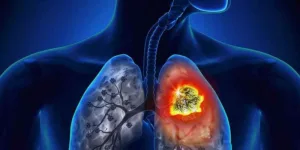Cancer is one of the most dangerous diseases, which evidently engulfs the lives of nearly 10% of the world’s population every year. A fatal ailment that typically develops as a result of an unhealthy lifestyle, weak immune system or acquired as a hereditary problem, cancer is hard to treat and even survive. Scientists and medical practitioners together are finding ways to treat cancer and increase survival rate.
However, cancer is a highly unpredictable disease. Women who’ve been lucky enough to survive breast cancer are more likely to either develop it again in the forthcoming year or face lung cancer as a consequence. While a plethora of researches has been conducted in analyzing a correlation between the two and checking how the latter condition can be kept at bay, not must have been gained yet apart from some “hit-and-trial” preventive measures such as limiting the radiation dose to the lungs, using a targeted treatment which only involves a small part of the breast, etc.
As a matter of fact, breast cancer is one of the most frequently diagnosed cancer samid women, with more than 3 million new cases diagnosed in 2018 in the United States alone.
Thanks to the development of smart tools and tests to like mammography, most women today, get diagnosed at an early stage. This means that the cancer type has only grown inside the breast and not spread beyond. Women who are diagnosed at an early stage have higher chances of getting cured and only a 1.3 percent risk of losing their lives to cancer if it reoccurs against at a later stage of their life.
Breast cancer treatments typically involve a limited breast surgery followed by targeted radiation treatments and chemotherapy. However, despite the cautious delivery of radiation, a small amount of radiation can spill into the lung, increasing the chances of malignancy there.
Making use of a complex predictive model known as the Biologic Effects of Ionizing Radiation (BEIR) VII, and by assessing multiple radiation techniques on realbreast models of cancer patients, a study by one of the leading oncologists of the world showcases that the risk of developing lung cancer slowly increases with the passage of time – nearly five to ten years after breast radiation treatment.
All It Takes – A Small Part of the Breast
The risk of developing lung cancer has become a real concern for young breast cancer patients diagnosed at an early stage. For instance, patients with ductal carcinoma in situ (DCIS), which is typically a form of non-invasive cancer and a highly curable disease, are more likely to experience the scary side-effects of the treatment, including lung cancer.
The upside of the situation is that the risk is not the same for all types of radiotherapies. Studies have shown that accelerated partial breast irradiation (APBI), a new form of radiotherapy for early-stage breast cancers can dramatically reduce the risk of developing lung cancer and similar fatal ailments. APBI smartly delivers radiation to only a small portion of the breast and typically focuses on the cavity left after the surgery, where the risk of cancer cells still servicing exists.
The advantages of using APBI are a plethora, including treatment delivery in a matter of just five days. Studies have found that the APBI treatment results are much better than exposing other body organs to radiation, including the lungs, to eliminate any and every kind of cancer cell present in and around the breast area. However, not all patients are likely to benefit from this fantastic treatment technique. Some may need more complex and extensive radiotherapy to get cured against breast cancer.
Tiny Radioactive Seeds can make a Difference
Among the tested APBI techniques, “brachytherapy” — a form of radiotherapy in which radioactive materials are implanted inside the surgical cavity, seems to be the safest option at hand. A specific form of brachytherapy called as the “permanent breast seed implant,” which was developed some of the leading scientists of cancer, state the technique as one of the best with the lowest risk of developing secondary lung cancer.
Brachytherapy, which is also used for effectively treating prostate cancer, involves permanent implantation of small radioactive seeds in the breast during a one-hour procedure that is performed under light sedation. The radiation emitted by these implanted radioactive seeds is so weak that it gets absorbed within a few millimeters of its range and hence, the technique hardly causes any damage to the nearly organs including the lungs.
The good news is that there’s still some room for improvement. For instance, making use of robotic radiation delivery, from all angles around the breast,which significantly reduces the chances of developing lung cancer, and so on.
The bottom line, breast cancer is one of the most common types of cancer diagnosed amid women across the globe. It’s effective and accurate treatment is essential to avoid cancer from relapsing and even increasing the risk of developing lung cancer. Taking proper care and paying attention to your body’s signals is equally important.








